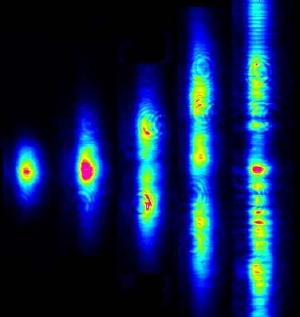Jul 2 2008
A new study undertaken by the non lineal optics and wave guides research group belonging to the department of Material Science of the UAM has advanced current understanding as well as the control of optical damage in crystals, offering new ways to increase light-power output of future optical integrated circuits.
 Fig.1 Illustration of the progressive degradation of a high intensity laser beam when propagating through a crystalline waveguide showing optical damage caused by photorefractive effect.
Fig.1 Illustration of the progressive degradation of a high intensity laser beam when propagating through a crystalline waveguide showing optical damage caused by photorefractive effect.
Many of the lasers used today, both in scientific or technological applications have such a high light output power that the light itself damages or even destroys the crystals used to control, guide or manipulate it inside photonic devices (devices that only work with light).
Even at not so high powers, distortion effects take place in crystalline materials that change the characteristics of the laser beam as it propagates through the material. This effect is called optical damage and is mainly caused by the photorefractive phenomenon, which is caused by the presence of defects or atomic impurities, the electrons of which are excited by the light and scatter within the material. This movement of electrons creates internal electrical fields that alter the refractive index of electrotropic crystals, hence affecting the propagation of the light through them.
In many cases, the photorefractive effect is useful. It grants control over the propagation of light in a crystal by means of other light beams and also allows the storage of information as holograms. Nevertheless, at high light intensities, the photorefractive effect strongly degrades the light beam, a fact which currently introduces great difficulties for the arrival of new photonic integrated devices such as micro lasers, electro optical modulators, or frequency transducers that require higher efficiencies at higher intensities.
For many years, researchers from the non lineal optics and wave guides group of the department of Material Science of the UAM have studied the response of one of the most used crystals in the history of photonics, lithium niobate, to intense laser light. Their knowledge has made possible the development of a model that explains the optical damage through photorefractive effects in this crystal but it can also be applied to other electro-optic crystals. The most relevant idea of this model is based on new discoveries relating to the atomic defects of crystals that influence the photo refraction at high light intensities as well as the capacity to amplify optical noise.
With this model the minimum light intensity (Sensory threshold) at which the damage appears, as a function of defect concentration, temperature and other crystal properties can be predicted. The study also offers scientists and physicists a guide to optimize the properties of the crystal and the design of devices, enabling a rise of the laser light intensity in the crystal to 106 W/cm2, which represents an increase of the damage intensity threshold of a normal crystal by a factor of 10,000.
This study was carried out by the researchers Mercedes Carrascosa, Angel García Cabañes, José Manuel Cabrera and the doctorate students Javier Villarroel y Jesús Carnicero from the department of Material Science of the UAM has been published in the prestigious magazine of the American optics society, “Optics Express” in January 2008 (vol. 16, pages 115-120)